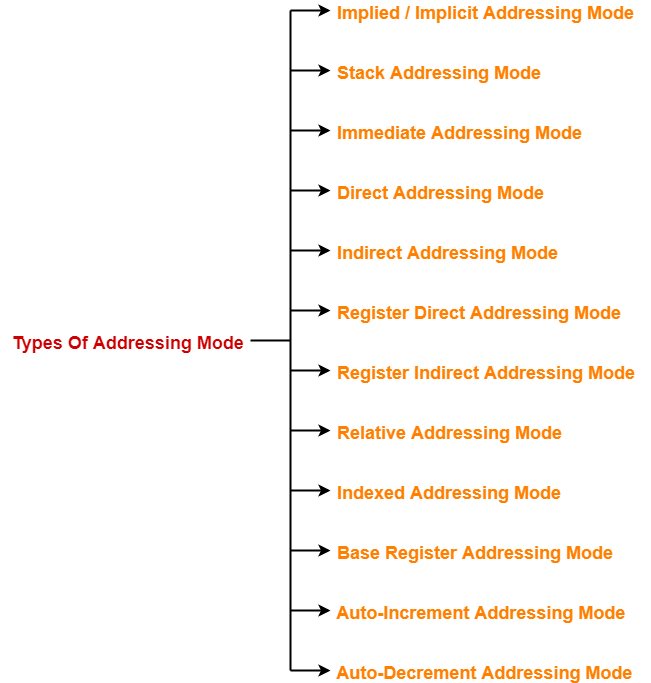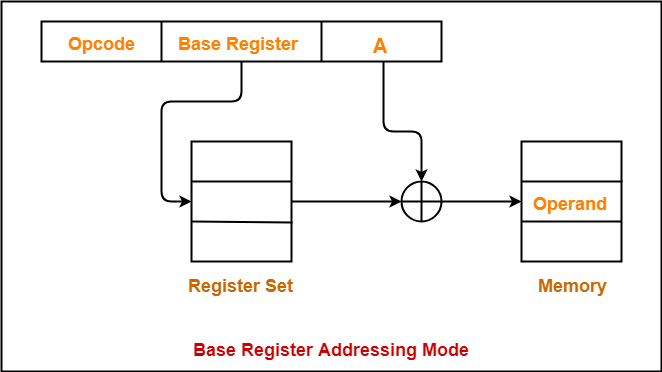Addressing Modes in Computer Architecture-
Before you go through this article, make sure that you have gone through the previous article on Addressing Modes.
We have discussed-
- Addressing modes are the different ways of specifying the location of an operand.
- Various kinds of addressing modes and their applications.

In this article, we will discuss syntax used for addressing modes.
Syntax Of Addressing Modes-
- The computer instructions may use different addressing modes.
- Different addressing modes use different syntax for their representation.
The syntax used for addressing modes are discussed below-
1. Immediate Addressing Mode-
Syntax-
# Expression
Interpretation-
Operand = Expression
Examples-
- Load R1, #1000 is interpreted as R1 ← 1000
- ADD R2, #3 is interpreted as R2 ← [R2] + 3
2. Direct Addressing Mode-
Syntax-
Constant
Interpretation-
Effective address of the operand = Constant
Operand = Content of the memory location ‘Constant’
Operand = [Constant]
Examples-
- Load R1, 1000 is interpreted as R1 ← [1000]
- ADD R2, 3 is interpreted as R2 ← [R2] + [3]
3. Register Direct Addressing Mode-
Syntax-
Rn or [Rn]
Interpretation-
Operand = Content of the register Rn
Operand = [Rn]
Examples-
- Load R1, R2 is interpreted as R1 ← [R2]
- ADD R1, R2 is interpreted as R1 ← [R1] + [R2]
4. Indirect Addressing Mode-
Syntax-
@Expression or @(Expression) or (Expression)
Interpretation-
Effective address of the operand = Content of the memory location ‘expression’
Operand = [[ Expression]]
Examples-
- Load R1, @1000 is interpreted as R1 ← [[1000]]
- ADD R1, @(1000) is interpreted as R1 ← [R1] + [[1000]]
- ADD R1, (1000) is interpreted as R1 ← [R1] + [[1000]]
5. Register Indirect Addressing Mode-
Syntax-
@Rn or @(Rn) or (Rn)
Interpretation-
Effective address of the operand = Content of the register Rn
Operand = [[ Rn ]]
Examples-
- Load R1, @R2 is interpreted as R1 ← [[R1]]
- ADD R1, @(R2) is interpreted as R1 ← [R1] + [[R2]]
- ADD R1, (R2) is interpreted as R1 ← [R1] + [[R2]]
6. Displacement Addressing Mode-
This addressing mode may be-
- Relative addressing mode
- Index addressing mode
- Base register addressing mode
Syntax-
disp (Rn)
Interpretation-
Effective address of the operand = disp + Content of the register Rn
Operand = [disp + [ Rn ]]
Examples-
- Load R1, 100(R2) is interpreted as R1 ← [100 + [R1]]
- ADD R1, 100(R2) is interpreted as R1 ← [R1] + [100 + [R2]]
7. Auto-Increment Addressing Mode-
Syntax-
(Rn)+
Interpretation-
Effective address of the operand = Content of the register Rn
Operand = [[ Rn ]]
After fetching the operand, increment [Rn] by step size ‘d’
Examples-
- Load R1, (R2)+ is interpreted as R1 ← [[R2]] followed by R2 ← [R2] + d
- ADD R1, (R2)+ is interpreted as R1 ← [R1] + [[R2]] followed by R2 ← [R2] + d
8. Auto-Decrement Addressing Mode-
Syntax-
-(Rn)
Interpretation-
Before fetching the operand, decrement [Rn] by step size ‘d’
Then, Effective address of the operand = Content of the register Rn
Operand = [[ Rn ]]
Examples-
- Load R1, -(R2) is interpreted as R2 ← [R2] – d followed by R1 ← [[R2]]
- ADD R1, -(R2) is interpreted as R2 ← [R2] – d followed by R1 ← [R1] + [[R2]]
To gain better understanding about Syntax of Addressing Modes,
Next Article- Practice Problems On Addressing Modes
Get more notes and other study material of Computer Organization and Architecture.
Watch video lectures by visiting our YouTube channel LearnVidFun.

